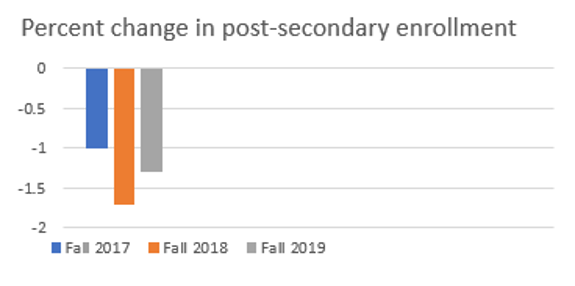
Why educators should be looking at marketing automation
When people hear the words education and automation in the same sentence, many automatically presume the topic is online education.
But automation crosses disciplines. As the population and social circumstances change, post-secondary education institutions face a shifting array of challenges, including attracting and retaining enrollment as well as reaching the segment that has left without completing degrees.
In the United States, we’re accustomed to thinking of college admissions as being highly competitive with the accompanying presumption that all institutions are full. Why would colleges that are turning applicants away be concerned with marketing?
What the numbers say
The facts paint a different picture. According to the National Student Clearinghouse Research Center, over the past three admissions years, overall postsecondary enrollment has decreased. While the 1.3 percent drop in 2019 represents a slight uptick from the previous year (a decrease of 1.7 percent), the overall trend is negative.

During the 2010s, unduplicated fall-term enrollments dropped below 18 million students and declined by more than two million students. The downward trend in enrollment is relatively new. According to the National Center for Education Statistics, Fall enrollment in degree-granting post-secondary institutions increased between 2006 (17.8 million students enrolled) and 2016 (19.8 million), followed by a decrease of 6 percent between 2010 and 2016 and continued decreases through 2019. Overall, a decade of declining enrollment.
Educational institutions must educate themselves
In this environment, it’s imperative to look for new approaches to reverse these trends. Marketing automation, often thought of as a capability solely built for business, is coming more to the forefront of solutions in education.
Think about decreasing enrollment. The capabilities of marketing automation can be valuable in identifying, reaching, and nurturing prospective students. By establishing ongoing personalized communications with this audience, institutions can identify trends in goals, interests, and obstacles that affect students and potential students. By reflecting that the school truly understands their concerns and directions, they can open a powerful communications channel and become a strongly considered destination option for those students.
In short, don’t let the name fool you. Marketing automation can provide educational institutions with comprehensive tools to address their current enrollment deficits as well as get ahead of the concerns that they will face in the coming years.
Clearer vision when looking ahead
Marketing automation can also be an important tool in helping administrations get in front of changing expectations of students. For example, the email marketing, events management, and survey capabilities in Microsoft Dynamics 365 Marketing provide college administrators and admissions departments insights into what students think of their education, the institution, their goals, their expectations, and other driving forces.
With that level of information coming in, educational decision-makers can make adjustments to demonstrate that they are responsive to student concerns. They can also better communicate their case as the destination-of-choice for cohorts as they arrive at college age. As the saying goes, knowledge is power.
Don’t overlook the returning student population. The National Student Clearinghouse Research Center reports that in the past five years, there have been 3.8 million “Some college, no degree” students who have re-enrolled. Staying meaningfully connected with them through continuing communications, perhaps even creating a personalized journey for them to guide their return, can have significant impact on enrollment over time.
Making technology more comfortable to use
Innovative solutions providers are refining their technologies and interfaces to integrate more readily into the halls of academia. Educational institutions benefit from developers’ experiences with business enterprises.
Businesses adopting marketing automation often look for the technology to be used across their marketing organization, reducing their reliance on technical people and support and empowering their own people. Technology solutions providers have responded by making the user interface and operation more accessible. That’s good news for educational institutions that could be wary of unanticipated or unwanted implementation and training obstacles.
Admissions and alumni relations organizations should look for built-in features such as easy email content design and email campaign management. Of course, every college participates in events, and any marketing automation solution they consider should offer extensive, easy-to-use event management capabilities.
Transforming from ivy-covered to data-driven
The trends are clear and so is the mandate—transform how you connect, communicate, and continue with your student population, both present and future.
In this pivotal moment, educational institutions must recognize that they need innovative solutions to address the societal transformations their students face. Marketing automation can help attract and enroll students more effectively and form a lasting relationship. In a competitive space, it differentiates your institution, provides a consistent message, demonstrates awareness and responsiveness to student needs, and helps you do what all outstanding places of learning must do—nurture relationships.
Read the Top Signs You’ve Outgrown Basic Email Marketing eBook to learn how Microsoft Dynamics 365 Marketing can be a transformative technology to your college or university. Sign up for a free trial of Dynamics 365 Marketing.



